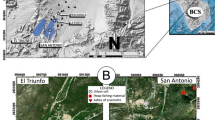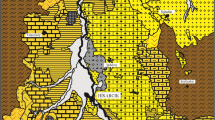Abstract
High concentrations of total arsenic (As) have been measured in soils of gold mining areas of Brazil. However, bioaccessibility tests have not yet been conducted on those materials, which is essential for better health risk estimates. This study aimed at evaluating As bioaccessibility in samples from a gold mining area located in Brazil and assessing children’s exposure to As-contaminated materials. Samples were collected from different materials (a control and four As-contaminated soils/sediments) found in a gold mine area located in Paracatu (MG), Brazil. Total and bioaccessible As concentrations were determined for all samples. The control soil presented the lowest As concentrations, while all other materials contained high total As concentrations (up to 2,666 mg kg−1) and low bioaccessible As percentage (<4.2%), indicating a low risk from exposure of resident children next to this area. The calculated dose of exposure indicated that, except for the pond tailings, in all other areas, the exposure route considering soil ingestion contributed at most to 9.7% of the maximum As allowed ingestion per day (0.3 μg kg−1 BW day−1).
Similar content being viewed by others
References
Agency for Toxic Substances and Disease Registry (ATSDR). (2007). Cercla priority list of hazardous substances, 2007. Accessed June 25, 2010 from http://atsdr.cdc.gov/cercla/07list.html.
Agency for Toxic Substances and Disease Registry (ATSDR). (2009). Minimal Risk Levels (MRLs). Accessed September 25, 2010 from http://www.atsdr.cdc.gov/mrls/mrls_list.html.
Andrade, R. P., Santana-Filho, S., Mello, J. W. V., Figueiredo, B. R., & Dussin, T. M. (2008). Arsenic mobilization from sulfidic materials from gold mines in Minas Gerais state. Química Nova, 31(5), 1127–1130.
Borba, R. P., Figueiredo, B. R., & Matschullat, J. (2003). Geochemical distribution of arsenic in waters, sediments and weathered gold mineralized rocks from iron quadrangle, Brazil. Environmental Geology, 44(1), 39–52.
Borba, R. P., Figueiredo, B. R., Rawlins, B., & Matschullat, J. (2000). Arsenic in water and sediment in the iron quadrangle, state of Minas Gerais, Brazil. Revista Brasileira de Geociência, 30(3), 558–561.
Bossy, A., Grosbois, C., Beauchemin, S., Courtin-Nomade, A., Hendershot, W., & Bril, H. (2010). Alteration of As-bearing phases in a small watershed located on a high grade arsenic-geochemical anomaly (French Massif Central). Applied Geochemistry, 25(12), 1889–1901.
Canadian Council of Ministers of the Environment (CCME). (1997). Canadian soil quality guidelines for the protection of environmental and human health: arsenic (inorganic) fact sheet. CCME (pp. 1–7).
Chung, E., Lee, J. S., Chon, H. T., & Sager, M. (2005). Environmental contamination and bioaccessibility of arsenic and metals around the Dongjeong Au-Ag-Cu mine, Korea. Geochemistry: Exploration, Environment, Analysis, 5(1), 69–74.
Conama, Resolução No420/2009. (2009). Valores orientadores de qualidade do solo quanto à presença de substâncias químicas, Conselho Nacional de Meio Ambiente, 2009. Accessed September 2, 2011 from http://www.mma.gov.br/port/conama/legiabre.cfm?codlegi=620.
De Miguel, E., Iribarren, I., Chacon, E., Ordonez, A., & Charlesworth, S. (2007). Risk-based evaluation of the exposure of children to trace elements in playgrounds in Madrid (Spain). Chemosphere, 66, 505–513.
Department for Environment, Food and Rural Affairs and the Environment Agency (DEFRA and EA). (2002). Soil guideline values for arsenic contamination. Bristol: Environment Agency.
Deschamps, E., Ciminelli, V. S. T., Lange, F. T., Matschullat, J., Raue, B., & Schmidt, H. (2002). Soil and sediment geochemistry of the iron quadrangle, Brazil. Journal of Soils and Sediments, 2(4), 216–222.
Dube, E. M., Petito Boyce, C., Beck, B. D., Lewandowski, T., & Schettler, S. (2004). Assessment of potential human health risks from arsenic in CCA-treated wood. Human and Ecological Risk Assessment, 10(6), 1019–1067.
Girouard, E., & Zagury, G. J. (2009). Arsenic bioaccessibility in CCA-contaminated soils: Influence of soil properties, arsenic fractionation and particle-size fraction. Science of the Total Environment, 407(8), 2576–2585.
Guilherme, L. R. G., & Marchi, G. (2007). Metais em Fertilizantes Inorgânicos: avaliação de risco à saúde após a aplicação. São Paulo: Associação Nacional para Difusão de Adubos.
Hemond, H. F., & Solo-Gabriele, H. M. (2004). Children’s exposure to arsenic from CCA-treated wooden decks and playground structures. Risk Analysis, 24(1), 51–64.
Juhasz, A. L., Smith, E., Weber, J., Rees, M., Rofe, A., Kuhcel, T., et al. (2007). In vitro assessment of arsenic bioaccessibility in contaminated (anthropogenic and geogenic) soils. Chemosphere, 69(1), 69–78.
Koch, I., Duso, A., Haug, C., Miskelly, C., Sommerville, M., Smith, P., et al. (2005). Distinguishing between naturally and anthropogenically elevated arsenic at an abandoned Artic military site. Environmental Forensics, 6(4), 335–344.
Koch, I., Sylvester, S., Lai, V. W. M., Owen, A., Reimer, K. J., & Cullen, W. R. (2007). Bioaccessibility and excretion of arsenic in Niu Huang Jie Du Pian pills. Toxicology and Applied Pharmacology, 222(3), 357–364.
Kwon, E., Zhang, H. Q., Wang, Z. W., Jhangri, G. S., Lu, X. F., Fok, N., et al. (2004). Arsenic on the hands of children after playing in playgrounds. Environmental Health Perspectives, 112(14), 1375–1380.
Ljung, K., Selinus, O., Otabbong, E., & Berglund, M. (2006). Metal and arsenic distribution in soil particle sizes relevant to soil ingestion by children. Applied Geochemistry, 21, 1613–1624.
Lu, Y., Yin, W., Zhang, G., Huang, L., & Zhao, Y. (2011). Assessment of bioaccessibility and exposure risk of arsenic and lead in urban soils of Guangzhou City, China. Environmental Geochemistry and Health, 33(2), 93–102.
Matschullat, J., Borba, R. P., Deschamps, E., Figueiredo, B. R., Gabrio, T., & Schwenk, M. (2000). Human and environmental contamination in the iron quadrangle, Brazil. Applied Geochemistry, 15, 181–190.
Meunier, L., Walker, S. R., Wragg, J., Parsons, M. B., Koch, I., Jamieson, H. E., et al. (2010). Effects of soil composition and mineralogy on the bioaccessibility of arsenic from tailings and soil in gold mine districts of Nova Scotia. Environmental Science and Technology, 44(7), 2667–2674.
Nathanail, C. P., McCaffrey, C., & Haynes, D. (2005). Assessing exposure to pedogenic arsenic contamination at a dwelling in Northamptonshire, UK: A case study. Soil Use and Management, 21, 508–517.
Oomen, A. G., Hack, A., Minekus, M., Zeijdner, E., Cornelis, S. C., Schoeters, G., et al. (2002). Comparison of five in vitro digestion models to study the bioaccessibility of soil contaminants. Environmental Science and Technology, 36(15), 3326–3334.
Palumbo-Roe, B., Cave, M. R., Klinck, B. A., Wragg, J., Taylor, H., O’Donnell, K. E., et al. (2005). Bioaccessibility of arsenic in soils developed over Jurassic ironstones in eastern England. Environmental Geochemistry and Health, 27(2), 121–130.
Palumbo-Roe, B., Klinck, B., & Cave, M. (2007). Arsenic speciation and mobility in mine wastes from a copper–arsenic mine in Devon, UK: An SEM, XAS, sequential chemical extraction study. Trace Metals and other Contaminants in the Environment, 9(6), 431–460.
Paustenbach, D. J. (2000). The practice of exposure assessment: A state-of-the-art review. Journal of Toxicology and Environmental Health Part B, 3(3), 179–291.
Pouschat, P., & Zagury, G. J. (2006). In vitro gastrointestinal bioavailability of arsenic in soils collected near CCA—treated utility poles. Environmental Science and Technology, 40(13), 4317–4323.
Rieuwerts, J. S., Searle, P., & Buck, R. (2006). Bioaccessible arsenic in the home environment in southwest England. Science of the Total Environment, 371, 89–98.
Rodriguez, R. R., Basta, N. T., Casteel, S. W., & Pace, L. W. (1999). An in vitro gastrointestinal method to estimate bioavailable arsenic in contaminated soils and solid media. Environmental Science and Technology, 33(4), 642–649.
Ruby, M. V., Davis, A., Schoof, R., Eberle, S., & Sellstone, C. M. (1996). Estimation of lead and arsenic bioavailability using a physiologically based extraction test. Science of the Total Environment, 30(2), 422–430.
Ruby, M. V., Schoof, R., Brattin, W., Goldade, M., Post, G., Harnois, M., et al. (1999). Advances in evaluating the oral bioavailability of inorganics in soil for use in human health risk assessment. Environmental Science and Technology, 33(21), 3697–3705.
Sarkar, D., Makris, K. C., Parra-Noonan, M. T., & Datta, R. (2007). Effect of soil properties on arsenic fractionation and bioaccessibility in cattle and sheep dipping vat sites. Environment International, 33(2), 164–169.
U.S. Environmental Protection Agency. (1998). Test methods for evaluation solid waste physical and chemical methods: Microwave assisted acid digest of sediments, sludges, soils and oils, SW-846. Washington, DC: U.S. Government Printing Office.
U.S. EPA (1998b) Integrated risk information system: Arsenic, inorganic; CASRN 7440-38-2; Environmental Protection Agency; U.S. Government Printing Office: Washington, DC.
U.S. Environmental Protection Agency. Child-specific exposure factors handbook. (2002). EPA/600/P-00/002B; Office of Research and Development; U.S. Government Printing Office: Washington, DC; Accessed June 25, 2010 from http://www.epa.gov/ncea.
Acknowledgments
The authors acknowledge The National Council for Scientific and Technological Development (CNPq Grant 577513/2008-7); The Research Foundation of the State of Minas Gerais (FAPEMIG Grants CAG PPM 187-09 & CAG APQ 118-09); and The Kinross Canada-Brazil Network for Advanced Education and Research in Land Resource Management for their financial support.
Author information
Authors and Affiliations
Corresponding author
Rights and permissions
About this article
Cite this article
Ono, F.B., Guilherme, L.R.G., Penido, E.S. et al. Arsenic bioaccessibility in a gold mining area: a health risk assessment for children. Environ Geochem Health 34, 457–465 (2012). https://doi.org/10.1007/s10653-011-9444-9
Received:
Accepted:
Published:
Issue Date:
DOI: https://doi.org/10.1007/s10653-011-9444-9




